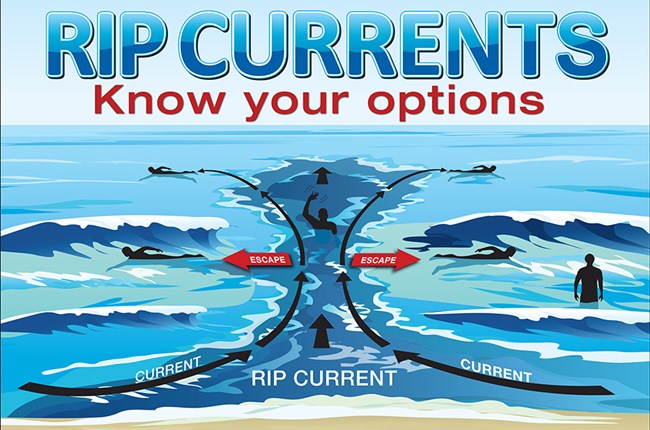A day at the beach typically involves swimming. If you intend to swim, please familiarize yourself with safe beach and ocean practices to ensure the protection of both the shoreline and your own safety.
NPS Photo/S.Godin Swim Safety SuggestionsPlease be aware that there are no lifeguards on any of the beaches at Cape Lookout National Seashore. Swim at your own risk. Currents, tide changes, winds, waves, and other factors should be considered when choosing if and where to swim. Before going in the water, spend a few moments watching the waves. Wave patterns are good indicators of the presence of currents, sand bars, and deep water troughs. 
Courtesy of NOAA Rip CurrentsRip currents—commonly called rip tides and incorrectly called undertows—are strong, narrow, river-like currents that are moving away from the shore. If you are caught in a rip current, do not panic. The current will pull you out into deeper water, but it will not pull you under. The best way to escape is to wade or swim parallel to the beach until you are out of the current. Then, when free, wade or swim back towards shore at an angle from the current. Do not attempt to swim directly against the current as you will only exhaust yourself. If you see someone else caught in a rip current, don't become a victim, too. Call 911. Send someone to the visitor center, cabin office, or other area where rangers and volunteers can be found. Throw the rip current victim something that floats—a lifejacket, a cooler, an inflatable ball. Yell instructions on how to escape. Certain weather conditions can make these currents stronger and more dangerous. Weak swimmers and children are advised to stay out of the ocean when there is an increased threat of rip currents, and even strong swimmers should stay out of the ocean on dangerous days. Rip Current advisories can be found posted at the park visitor centers or on NOAA's beach forecast.
Know Before You Jump In Review these tips before you jump into the water!
Swimming is prohibited within 50 feet of the passenger ferry dock in the lighthouse area. This closure is marked by buoys. The Beaufort Inlet beach on the western end of Shackleford Banks is closed to swimming due to the strong currents from the inlet. This closure is marked by signs on the beach.
Most jellyfish found on our beaches are harmless to humans, but people who are allergic to bee or ant stings should exercise extreme caution. Occasionally, winds can wash Portuguese Man-o-wars ashore. Although these are not technically jellyfish, their stings are very painful and potentially dangerous. Even after the animal is dead, its tentacles can sting. Never touch a jellyfish on the beach. Walk around the jellyfish on the dune side to avoid tentacles between the jellyfish and the water. Tentacles should be removed from a sting with a towel, credit card, or another item, but never with bear hands. If the area of the sting is large or if the victim shows signs of an allergic reaction, seek immediate medical attention. Most people can swim in the ocean their entire lives without ever seeing a shark. To avoid meeting a shark: swim in a group; stay close to shore; don't swim at night, dusk, or dawn; don't wear jewelry or other reflective items; and use caution when swimming in inlets, steep drop-offs, the area between sandbars, and other places with concentrated numbers of fish.
The sharp spine at the base of the stingray's tail can deliver a painful wound. Most stings occur when people step on the rays. To avoid this, you should shuffle your feet as you walk in the water. Stingray wounds should be washed and cleaned. If possible, soak the are in water as hot as can be tolerated for 30 to 90 minutes. Seek medial attention as soon as possible
|
Last updated: April 9, 2025
